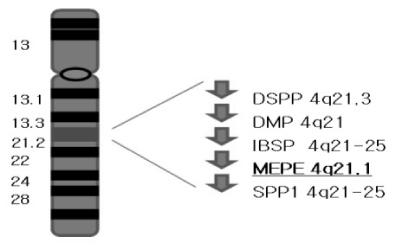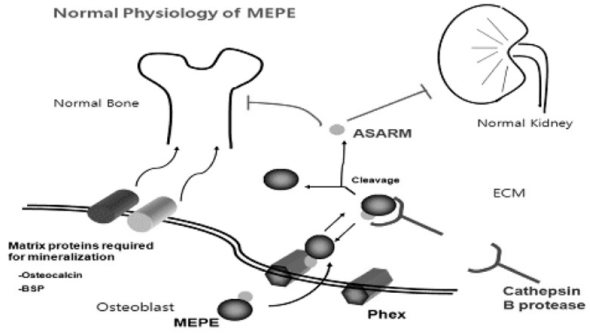J Korean Endocr Soc.
2008 Apr;23(2):71-75. 10.3803/jkes.2008.23.2.71.
MEPE: A Mineralization Regulating Bone Matrix Protein
- Affiliations
-
- 1Department of Cell and Developmental Biology, School of Dentistry, Seoul National University, Seoul, Korea.
- KMID: 2063558
- DOI: http://doi.org/10.3803/jkes.2008.23.2.71
Abstract
- No abstract available.
MeSH Terms
Figure
Reference
-
1. Bonewald LF. Mechanosensation and transduction in osteocytes. Bonekey Osteovision. 2006. 3:7–15.2. Boneward Lynda F.. Osteocytes as dynamic, multifunctional cells. Ann NY Acad Sci. 2007. 1116:281–290.3. Rowe PS, de Zoysa PA, Dong R, Wang HR, White KE, Econs MJ, Oudet CL. MEPE, a new gene expressed in bone marrow and tumors causing osteomalacia. Genomics. 2000. 67:54–68.4. Petersen DN, Tkalcevic GT, Mansolf AL, Rivera-Gonzalez R, Brown TA. Identification of osteoblast/osteocyte Factor 45 (OF45), a bone-specific cDNA encoding an RGD-containing protein that is highly expressed in osteoblast and osteocytes. J Biol Chem. 2000. 275:36172–36180.5. MacDougall M, Simmons D, Gu TT, Dong J. MEPE/OF45, a new dentin/bone matrix protein and candidate gene for dentin diseases mapping to chromosome 4q21. Connect Tissue Res. 2002. 43:320–330.6. Quarles LD. FGF23, PHEX, and MEPE regulation of phosphate homeostasis and skeletal mineralization. Am J Physiol Endocrinol Metab. 2003. 285:E1–E9.7. Nagel DE, Khosla S, Sanyal A, Rosen DM, Kumagai Y, Riggs BL. A fragment of the hypophosphatemic factor, MEPE, requires inducible cyclooxygenase-2 to exert potent anabolic effects on normal human marrow osteoblast precursors. J Cell Biochem. 2004. 93:1107–1114.8. Rowe PS, Kumagai Y, Gutierrez G, Garrett IR, Blacher R, Rosen D, Cundy J, Navvab S, Chen D, Drezner MK, Quarles LD, Mundy GR. MEPE has the properties of an osteoblastic phosphatonin and minhibin. Bone. 2004. 34:303–319.9. Six N, Septier D, Chaussain-Miller C, Blacher R, DenBesten P, Goldberg M. Dentonin, a MEPE fragment, initiates pulp-healing response to injury. J Dent Res. 2007. 86:780–785.10. Lu C, Huang S, Miclau T, Helms JA, Colnot C. Mepe is expressed during skeletal development and regeneration. Histochem Cell Biol. 2004. 121:493–499.11. Bresler D, Bruder J, Mohnike K, Fraser WD, Rowe PS. Serum MEPE-ASARM- peptides are elevated in X-linked rickets (HYP): implications for phosphaturia and rickets. J Endocrinol. 2004. 183:R1–R9.12. White KE, Larsson TE, Econs MJ. The roles of specific genes implicated as circulating factors involved in normal and disordered phosphate homeostasis: frizzled related protein-4, matrix extracellular phosphoglycoprotein, and Fibroblast Growth Factor 23. Endocr Rev. 2006. 27:221–241.13. Rowe PS, Oudet CL, Francis F, Sinding C, Pannetier S, Econs MJ, Strom TM, Meitinger T, Garabedian M, David A, Macher MA, Questiaux E, Popowska E, Pronicka E, Read AP, Mokrzycki A, Glorieux FH, Drezner MK, Hanauer A, Lehrach H, Goulding JN, O'Riordan JL. Distribution of mutations in the PEX gene in families with X-linked hypophosphataemic rickets (HYP). Human Molecular Genetics. 1997. 6:539–549.14. Dobbie H, Unwin RJ, Faria NJ, Shirley DG. Matrix extracellular phosphoglycoprotein causes phosphaturia in rats by inhibiting tubular phosphate reabsorption. Nephrol Dial Transplant. 2008. 23:730–733.15. Liu S, Rowe PS, Vierthaler L, Zhou J, Quarles LD. Phosphorylated acidic serine-aspartate-rich MEPE-associated motif peptide from matrix extracellular phosphoglycoprotein inhibits phosphate regulating gene with homologies to endopeptidases on the X-chromosome enzyme activity. J Endocrinol. 2007. 192:261–267.16. Berndt TJ, Schiavi S, Kumar R. "Phosphatonins" and the regulation of phosphorus homeostasis. Am J Physiol Renal Physiol. 2005. 289:F1170–F1182.17. Laroche M, Boyer JF. Phosphate diabetes, tubular phosphate reabsorption and phosphatonins. Joint Bone Spine. 2005. 72:376–381.
- Full Text Links
- Actions
-
Cited
- CITED
-
- Close
- Share
- Similar articles
-
- Influence Of Co-Cultured Fibroblasts On The Differentiation Of Mouse Calvaria-Derived Undifferentiated Mesenchymal Cells In Vitro
- Cellular zinc deficiency inhibits the mineralized nodule formation and downregulates bone-specific gene expression in osteoblastic MC3T3-E1 cells
- A study on a culture of human alveolar bone cells
- Angiogenesis and Mineralization During Distraction Osteogenesis
- The effect of dexamethasone on the gene expression of the bone matrix protein in the periodontal ligament cells




